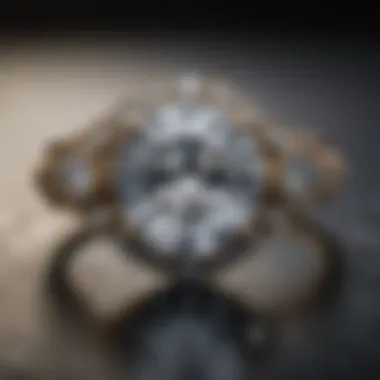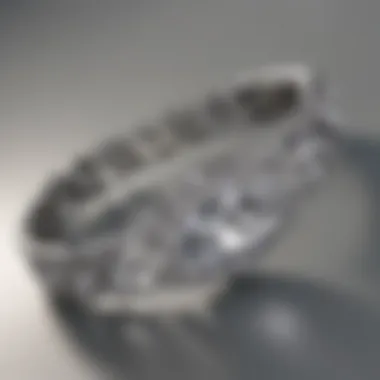Unveiling the Distinctions Between White Sapphire and Diamond: A Comprehensive Analysis


Overview of Gemstones and Minerals
Gemstones and minerals have long been revered for their beauty and rarity. They hold significant historical and cultural importance, serving as symbols of power, wealth, and status. Throughout the centuries, gemstones and minerals have captivated diverse societies, found in adornments, talismans, and religious artifacts.
Gemstone Formation and Properties
The formation of gemstones is a complex process that spans millions of years. Gemstones are created deep within the Earth's crust, undergoing intense pressure and heat, resulting in their unique crystalline structures and vibrant colors. Properties like color, hardness, and luster distinguish gemstones, with each gem type possessing its own set of defining characteristics.
Types of Gemstones
Gemstones are broadly categorized into precious and semi-precious categories based on their rarity and value. Precious gemstones, like diamonds, rubies, sapphires, and emeralds, are highly coveted for their exceptional beauty and scarcity. In contrast, semi-precious gemstones encompass a wider range of stones, including amethyst, citrine, and turquoise, prized for their aesthetic appeal and affordability.
Identifying and Evaluating Gemstones
When evaluating gemstones, several factors contribute to their overall value, including color, clarity, carat weight, and cut. Gemologists employ various techniques like visual inspection, spectroscopy, and magnification to assess gemstone quality accurately. Each gemstone is unique, and proper evaluation is crucial in determining its authenticity and market worth.
Caring for Gemstones
Proper care and maintenance are essential to preserve the beauty and longevity of gemstones. Routine cleaning, storage in a soft pouch or fabric-lined jewelry box, and protection from harsh chemicals can ensure the gemstones retain their shine and brilliance. Different gem types, such as diamonds and sapphires, may require specific care instructions due to variations in their hardness and durability.
Introduction
In the realm of precious gemstones, two coveted beauties stand out: white sapphire and diamond. This detailed guide aims to dissect the nuances that differentiate these dazzling gems, providing a wealth of information for gemstone enthusiasts and jewelry connoisseurs alike. By unraveling their distinct compositions, physical properties, and market values, readers will embark on a journey of enlightenment into the intricate world of gemstones.
Welcome to the World of Gems
Brief Overview of Gemstones
Embarking on our exploration, it's essential to grasp the fundamental essence of gemstones. These natural wonders have fascinated civilizations for centuries, admired for their inherent beauty and rarity. Gemstones, including white sapphire and diamond, hold a timeless allure, symbolizing luxury, elegance, and sophistication in the jewelry industry. Their mesmerizing allure captivates the eye and adds a touch of opulence to any piece of jewelry, making them prized possessions for those with a discerning taste for the finer things in life.
Significance of White Sapphire and Diamond
Role in Jewelry Industry
Delving deeper, the significance of white sapphire and diamond in the jewelry industry cannot be overstated. White sapphire, with its ethereal clarity and brilliant sparkle, is often used as a captivating alternative to diamond in various jewelry pieces. Its affordability coupled with its striking resemblance to a diamond makes it a popular choice among individuals seeking elegance without the exorbitant price tag. On the other hand, diamonds reign supreme as the ultimate symbol of everlasting love and luxury. Their unparalleled hardness and unparalleled brilliance have solidified diamonds as the go-to gemstone for engagement rings and high-end jewelry pieces, symbolizing eternal love and unbreakable bonds.


Composition and Structure
In this segment of the article, we delve into the fundamental aspects that distinguish white sapphire from diamond based on their composition and structure. Understanding the chemical makeup and crystal structure of gemstones is crucial in differentiating their properties and quality. The intricacies of their composition influence attributes like hardness, brilliance, and overall appearance. By examining these elements, we can discern why white sapphire and diamond stand out in the world of gemstones.
Chemical Makeup
The chemical makeup of white sapphire and diamond plays a pivotal role in determining their distinct characteristics. White sapphire, composed of aluminum oxide, derives its colorlessness from the absence of trace elements that usually impart hues to gemstones. In contrast, diamonds are made of carbon atoms arranged in a crystal lattice structure. This composition results in their renowned durability and scintillating sparkle. The elemental purity of white sapphire and the carbon structure of diamonds define their optical properties, making them sought-after gems in the jewelry industry.
Elements Present in White Sapphire and Diamond
White sapphires primarily consist of aluminum oxide with traces of iron, titanium, and chromium. The absence of other elements like corundum is what gives white sapphire its signature colorlessness and transparency. On the other hand, diamonds are pure carbon crystals formed under immense pressure and heat. This elemental composition is responsible for the exceptional hardness and brilliance of diamonds that set them apart from other gemstones. The clarity and reflective properties of diamonds stem from their carbon makeup, making them a preferred choice for exquisite jewelry pieces.
Crystal Structure
The crystal structure of gemstones defines their physical properties, including clarity, brilliance, and durability. How atoms align within a gemstone's structure impacts its overall appearance and strength. White sapphires exhibit a trigonal crystal structure, characterized by a hexagonal shape with triangular facets. This arrangement allows light to pass through the gemstone, creating a subtle glow unmatched by other gems. Diamonds, with a cubic crystal structure, showcase unparalleled brilliance due to their symmetrical arrangement of carbon atoms. The geometric precision of diamond's crystal lattice maximizes light reflection and refraction, resulting in the captivating sparkle that has fascinated gem enthusiasts for centuries.
Arrangement of Atoms
The arrangement of atoms within white sapphire and diamond crystals dictates their optical properties and physical resilience. White sapphires feature a compact structure where aluminum oxide molecules align in a repeating pattern. This orderly arrangement enhances the gem's transparency and luster, making it an exquisite choice for elegant jewelry designs. In contrast, diamonds' tightly bonded carbon atoms form a rigid, three-dimensional lattice structure known as a diamond cubic crystal system. This robust arrangement accounts for the exceptional hardness and refractive index of diamonds, making them the epitome of luxury and sophistication in the world of gemstones.
Physical Properties
Physical properties play a crucial role in distinguishing between white sapphire and diamond. Understanding the physical characteristics of these gemstones is essential for gem enthusiasts, collectors, and jewelry designers. By scrutinizing the hardness, durability, brilliance, and sparkle of white sapphire and diamond, one can appreciate their significance in the gemstone world.
Hardness and Durability
Delving into the hardness and durability of white sapphire and diamond illuminates the differences between these two gemstones. The Mohs Scale is a valuable tool for comparing the hardness of minerals. White sapphire ranks slightly lower on the scale compared to diamond, showcasing variations in durability. This distinction influences their longevity and wearability in different settings, making it imperative for individuals to consider the intended use of the gemstone. The Mohs Scale comparison provides insights into the resilience and robustness of white sapphire and diamond, aiding consumers in making informed choices based on their lifestyle and preferences.
Mohs Scale Comparison
Examining the Mohs Scale Comparison between white sapphire and diamond offers a unique perspective on their physical properties. The Mohs Scale, developed by Friedrich Mohs, ranks minerals based on their scratch resistance. Diamond, with a perfect score of 10, exemplifies unparalleled hardness, making it ideal for everyday wear and long-lasting jewelry pieces. On the other hand, white sapphire, with a score close to diamond but marginally lower, remains a durable gemstone suitable for various jewelry settings. Understanding the Mohs Scale Comparison empowers gem enthusiasts to appreciate the intricate differences in hardness and durability between white sapphire and diamond, guiding them towards selecting the most appropriate gemstone for their desired aesthetics.
Brilliance and Sparkle
The brilliance and sparkle of gemstones are enchanting attributes that draw admiration from all corners. Examining the reflective index differences between white sapphire and diamond sheds light on their distinct optical properties. By analyzing how light interacts with these gemstones, one can discern their unique reflective characteristics that define their visual appeal.


Reflective Index Differences
The reflective index differences between white sapphire and diamond unveil fascinating insights into their visual allure. Diamond's high reflective index enables it to refract light exceptionally, resulting in superb brilliance and fire that captivate onlookers. Conversely, white sapphire, while possessing brilliance, exhibits subtle differences in its reflective index, creating a distinctive play of light. This variation impacts the gemstones' sparkle and scintillation, influencing the overall aesthetics of jewelry pieces adorned with white sapphire or diamond. By understanding the reflective index differences, gemstone enthusiasts can gain a deeper appreciation for the unique beauty each gemstone embodies, facilitating informed decisions when selecting gemstone jewelry.
Color and Clarity
Color and clarity play pivotal roles when comparing white sapphire and diamond, adding intricate layers of distinction that discerning enthusiasts value immensely. The exquisite interplay of color saturation and transparency determines the allure and brilliance of these gemstones, conveying their uniqueness and character.
Presence of Color
When delving into the realm of color variations in white sapphire and diamond, it becomes apparent that each gem exhibits its distinctive hues. White sapphires are known for their colorlessness, reflecting a pure and serene aesthetic that appeals to those seeking a subtle elegance. On the other hand, diamonds boast a diverse spectrum of colors, ranging from dazzling whites to fancy intense hues, offering a broad palette for jewelry connoisseurs to explore. The contrasting charm of white sapphire's ethereal clarity against the vibrant hues found in diamonds provides a captivating visual experience for gem enthusiasts.
Clarity Characteristics
Inclusions and flaws serve as defining characteristics of white sapphire and diamond, influencing their overall quality and desirability in the eyes of collectors and designers alike. White sapphires typically showcase fewer inclusions compared to diamonds, emphasizing their pristine clarity and understated beauty. Alternatively, diamonds may contain various flaws such as feathers, clouds, or crystals, contributing to their unique fingerprint and individuality. The absence or presence of these clarity characteristics deeply impacts the gemstone's brilliance, with each imperfection adding a layer of intrigue and complexity to the stone's visual appeal.
Value and Pricing
In this section of the article, we will delve into the crucial aspect of value and pricing concerning white sapphire and diamond. Understanding the monetary worth of these gemstones is fundamental for enthusiasts and collectors alike. The pricing of gemstones is influenced by various factors, including rarity, demand, and market trends. By comprehending the dynamics of value and pricing, individuals can make informed decisions when investing in these precious stones.
Factors Influencing Value
Rareness and Demand
Rareness and demand play a significant role in determining the value of white sapphire and diamond. The rarity of a gemstone, coupled with its desirability in the market, can significantly impact its price. Gemstones that are scarce and in high demand tend to command higher prices due to their exclusivity. The unique allure of rare gemstones often makes them highly sought after by collectors and connoisseurs. However, with increased demand comes the risk of inflated prices, leading to fluctuating market conditions that can influence pricing trends.
Market Trends
Market trends are another vital factor that influences the value and pricing of gemstones. Understanding the market dynamics, including price fluctuations, allows stakeholders to make informed decisions regarding buying and selling gemstones. Price fluctuations can be influenced by various external factors such as economic conditions, consumer preferences, and global events. By staying abreast of market trends and analyzing price fluctuations, individuals in the gemstone industry can better navigate the complexities of pricing structures and capitalize on favorable market conditions.
Industrial Applications
In the vast realm of gemstones, understanding their industrial applications plays a crucial role in appreciating their multifaceted significance. White sapphire and diamond, both esteemed gemstones, find widespread utilization across various industries, making them indispensable resources for numerous applications. Exploring the industrial applications of these gemstones unveils a realm where their unparalleled properties contribute to enhancing processes and products in sectors such as technology, healthcare, and manufacturing.
Usage in Various Industries


Gemstone Applications
Gemstone applications encompass a diverse array of uses that underline the versatility and functionality of white sapphire and diamond in numerous industries. The exceptional hardness and optical properties of white sapphire make it a preferred choice for high-tech applications such as optical components, where its durability and clarity are essential. Diamond, renowned for its unparalleled hardness, finds extensive use in industrial cutting, drilling, and grinding tools, accentuating its exceptional wear resistance and thermal conductivity. The unique feature of gemstone applications lies in their ability to withstand extreme conditions and pressures, making them invaluable assets across industries where precision and reliability are paramount. Despite their differences in composition and structure, both white sapphire and diamond exhibit characteristics that make them indispensable for diverse industrial purposes, highlighting their enduring relevance and practical utility.
Technological Uses
Diamonds in Technology
Technology harnesses the remarkable properties of diamonds to revolutionize various sectors, showcasing their exceptional attributes beyond traditional adornment. The key characteristic of diamonds in technology lies in their exceptional hardness, conductivity, and thermal stability, making them ideal candidates for cutting-edge applications in electronics, medical devices, and scientific instruments. The unique feature of diamonds is their ability to dissipate heat efficiently, enhancing the performance and longevity of electronic components in power systems and advanced machinery. While diamonds offer unparalleled advantages in technological innovation, their high cost and limited supply pose challenges in widespread integration, necessitating strategic planning and utilization to optimize their benefits. By exploring the technological uses of diamonds, industries can unlock new possibilities for enhancing efficiency, durability, and precision in various applications, shaping the future of advanced technology with the enduring brilliance and resilience of these extraordinary gemstones.
Care and Maintenance
In the realm of gemstones, care and maintenance play a pivotal role in preserving the brilliance and allure of white sapphires and diamonds. Understanding the significance of proper upkeep is crucial for ensuring the longevity and luster of these precious stones. Efficient care practices not only enhance the aesthetic appeal but also safeguard the gemstones from potential damage and wear over time. By adhering to specific care routines, individuals can maintain the pristine beauty of their jewelry pieces and uphold the value of these exquisite gemstones.
Cleaning and Storage
Best Practices
When it comes to maintaining the radiance of white sapphires and diamonds, implementing best practices for cleaning and storage is imperative. Utilizing mild detergent solutions and soft brushes, individuals can gently cleanse their gemstones to eliminate dirt and maintain their natural sheen. Proper storage in padded jewelry boxes or cloth pouches helps prevent scratches or impact damage, ensuring the gemstones retain their original brilliance. Regular cleaning at home and periodic professional maintenance can prolong the lifespan of white sapphires and diamonds, preserving their elegance for generations to come.
Avoiding Damage
Precautionary Measures
In the context of care and maintenance, adopting precautionary measures is vital for safeguarding white sapphires and diamonds from potential harm. Handling gemstones with care and avoiding exposure to harsh chemicals or extreme temperatures are fundamental precautions to prevent damage. Moreover, removing jewelry during strenuous activities or when using cleaning agents prevents accidental scratches or chemical reactions that may affect the gemstones' clarity. By taking proactive steps to protect these precious stones, individuals can ensure the longevity and beauty of their white sapphires and diamonds, maintaining their allure for years to come.
Conclusion
In this comprehensive exploration of the disparities between white sapphire and diamond, key insights shed light on the distinct characteristics, properties, and values associated with these luminous gemstones. The significance of understanding the variances between these coveted gems lies in the ability to make informed decisions when selecting the ideal gemstone for jewelry or other applications. By delving deep into the nuanced differences between white sapphire and diamond, readers can appreciate the craftsmanship and geological uniqueness that distinguish these gemstones in the jewelry industry.
Summing Up the Contrasts
Key Differences Highlighted
The highlighted key differences between white sapphire and diamond encompass a broad spectrum of factors, from chemical composition to physical properties. One crucial distinction lies in the chemical makeup, where white sapphire comprises aluminum oxide while diamond consists of pure carbon. This fundamental variance not only dictates the gemstones' structural composition but also influences their brilliance and color dispersion. White sapphire's mineral structure contributes to its remarkable durability, ranking high on the Mohs scale, while diamond's crystalline lattice ensures exceptional hardness. The unique feature of white sapphire's affordability paired with diamond's unrivaled brilliance showcases a stark contrast for consumers seeking both elegance and economic value.
Final Thoughts
Choosing the Right Gemstone
The decision-making process when choosing between white sapphire and diamond encapsulates a blend of personal preference and practical considerations. Opting for white sapphire appeals to individuals valuing affordability without compromising on aesthetics, making it an excellent choice for those seeking a sophisticated yet cost-effective gemstone. On the other hand, selecting a diamond underscores a commitment to timeless elegance and enduring quality, ideal for those prioritizing luxury and prestige. The unique feature of versatility in style and design options offered by white sapphire, juxtaposed with the unparalleled status symbol associated with diamond, presents a compelling choice for discerning consumers looking to embody their desired style and status through exquisite gemstones.







